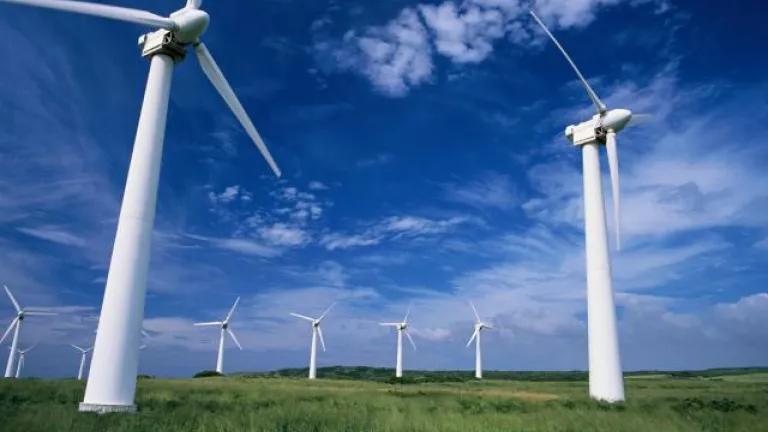Time to Protect Clean Energy by Ending PG&E’s Bankruptcy

The Pacific Gas & Electric Company (PG&E) has been in bankruptcy for fifteen months. The process has reached a critical stage, and state and federal regulatory proceedings need to conclude before June 30 in order to meet a crucial deadline established last year by the California legislature. Otherwise, important clean energy programs vital to meeting California’s climate goals will be at risk, and uncertainties regarding wildfire victims’ compensation will increase at what may well be the worst possible time.
The amended reorganization proposal endorsed by Governor Newsom on March 20 significantly strengthens the utility’s clean energy and climate commitments and adds further improvements. Under California law, PG&E’s proposal must be “consistent with the state’s climate goals.” We believe it is, and NRDC has submitted testimony supporting the plan’s clean energy provisions to the California Public Utilities Commission (CPUC). A federal bankruptcy judge and the CPUC now share primary responsibility for determining PG&E’s future.
From an environmental perspective, the PG&E reorganization plan goes well beyond earlier commitments to honor the company’s contracts to purchase electricity from renewable energy providers. These contracts represent a necessary but not sufficient condition for sustained environmental progress throughout (and well beyond) the utility’s Florida-sized service territory.
During the bankruptcy period, PG&E has kept its clean energy commitments, including contract payments and pre-existing programs, and the utility has established a post-bankruptcy agenda that keeps clean energy front and center.
Highlights include (quoting directly from the company’s filing with the CPUC in support of the amended reorganization plan):
- Going forward, we are committed to meeting California’s vision for a sustainable energy future, including implementation of (SB) 100, and carbon neutrality by 2045, in a reliable and cost-effective manner for customers.
- PG&E works with broad industry and non-governmental entity coalitions to advocate for a federal price on carbon to reduce greenhouse gas emissions, and amplify our experience in California as proof positive that it is possible to grow the economy and reduce greenhouse gas emissions at the same time.
- PG&E also supports California’s stringent greenhouse gas tailpipe emissions standards, as well as advancing electric vehicle adoption by providing tax incentives and support for charging infrastructure. In 2019, as part of its membership in the National Coalition for Advanced Clean Air Transportation, PG&E joined California and several other states in a lawsuit against revising the EPA’s existing greenhouse gas emission standards.
- We also welcome the opportunity to avoid investments in new gas assets that may later prove underutilized as local governments and the state work together to meet long term decarbonization objectives. We have supported several local ordinances to ban the use of natural gas in new buildings
- We will advocate for stronger building codes and appliance standards in collaboration with entities like the California Energy Commission, while continuing to serve as California’s statewide coordinator for utility initiatives and analyses on standards.
- [We will maintain] our longstanding leadership role in the nation’s first interdisciplinary energy efficiency institute at the University of California Davis and in the “best practices” clearinghouse for EE and demand response at the Consortium for Energy Efficiency.
- We support the state’s goals of five million zero emission vehicles (ZEV) on the road by 2030, supported by 250,000 charging stations, including 10,000 fast chargers, and 200 hydrogen fueling stations statewide by 2025.
- The utility is on track to meet its 60 percent by 2030 RPS procurement mandate. In 2018, all electricity retail sellers had an annual target to serve at least 29 percent of their electric load with RPS-eligible resources. In 2018, we surpassed that target, delivering 38.9 percent of our bundled load from RPS-eligible resources (substantially exceeding the annual target of 29 percent).
- In 2016, PG&E, labor unions, environmental groups, and community organizations sought CPUC approval for a Joint Proposal to retire the (Diablo Canyon) nuclear facility at the end of its current operating licenses, in 2024 and 2025. Underpinning the agreement was the recognition that California's new energy policies will significantly reduce the need for Diablo Canyon's electricity output. PG&E has worked with the Commission and stakeholders in the Integrated Resource Planning process to ensure that the Integrated Resource Planning process avoids any increase in emissions of greenhouse gases as a result of the retirement of Diablo Canyon.
As the largest utility in California, PG&E’s clean energy programs and investments have a significant role to play in the state’s climate future. But the company must first emerge from bankruptcy. Governor Newsom has led in this effort, and even renowned PG&E critic Erin Brockovich is an Aye vote, along with representatives of wildfire victims and communities across Northern California. In joining with them, NRDC looks forward to a prompt resumption of PG&E’s clean energy progress.



